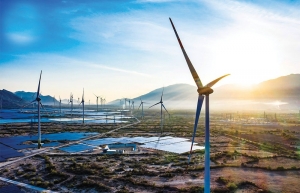Power plan shapes development direction
According to the plan, electricity demand is expected to grow by 8.8 per cent over this decade, which is followed by an average growth of 4-4.7 per cent in the 2031-2050 period. This is a very high growth rate, but there are three factors that need to be carefully re-considered.
 |
| Dr. Nguyen Anh Tuan - Senior expert Vietnam Energy Association |
Firstly, the future price of electricity has a major impact on load demand, electricity savings, and the elasticity coefficient. Assuming that the increase in electricity prices is fast enough to compensate for power production costs, and to strongly promote energy-saving measures. It is possible to save up to 30 per cent of electricity, which is much higher than the projection of 8-10 per cent in the PDP8.
The second is the electrification of transportation. Given that the transportation electrification rate remains high until 2040, the required capacity for electric vehicles can be up to 50-80GW and the energy consumption can be up to 40-50 billion kWh. This will greatly affect the load in terms of both capacity and power.
The third is to manage the demand for decentralised energy sources. When constraints for small self-production and self-consumption power sources no longer exist in the future, these sources are expected to develop quickly and widely. This can exert a strong impact on the load demand and consumption patterns (load profile).
According to the development scenario under the PDP8, Vietnam plans to shift away from fossil fuel-derived energy towards low-carbon energy sources. The country’s gas consumption is also forecast to increase in the medium and long term. The long-term strategy is to develop a roadmap to switch from LNG power plants to hydrogen use in the power structure.
The contribution of hydrogen and ammonia fuels to the energy mix is forecast to increase in the future, thereby helping Vietnam fulfill its net-zero emissions commitment by 2050. The proportion of gas in the composition of fuel and electricity generation will increase from about 15.9 per cent in 2025 to 26.7 per cent in 2030. However, this figure is projected to decrease to 20.7 per cent in 2045. This trend indicates that natural gas is seen as a short-term factor in Vietnam’s energy transition roadmap.
Therefore, Vietnam needs to set requirements early in the design phase of power plants to avoid the risk of stranded assets in the future and be ready for the scenario of hydrogen use. In particular, it is important for Vietnam to have a green hydrogen strategy in its energy transition roadmap.
Accordingly, the country needs to clearly define the role of hydrogen in Vietnam’s energy sector, ensuring harmonisation between renewable energy development and hydrogen consumption. Hydrogen gas can be seen as an efficient way to utilise renewable energy, especially when there is an oversupply.
A study on “the future of Vietnam’s power industry” by the Australian government, released in May, shows that even when adding costs to balance the system cost, solar energy, wind energy, and stored hydroelectricity will always new forms of low-cost electricity generation.
In the case of Vietnam, a clear, long-term, and predictable renewable energy development policy is a prerequisite for a sustainable energy transition. The enactment of the Law on Renewable Energy should be a top priority.
However, there are legal bottlenecks for the private sector to invest in transmission grids and directly sell electricity. The amended Law on Electricity in 2022 emphasises stable, safe, and cost-effective power supply, allowing economic sectors to invest in and operate transmission grids. However, there are no decrees or implementation guidelines so far.
The process of energy transition is associated with the development of energy infrastructure. If well implemented, it will encourage Vietnam to achieve the goals of economic, social, and environmental development synchronously, meeting the country’s long-term vision. Many countries pursuing low-carbon development strategies will have a better chance of accessing resources to develop a prosperous economy in this century.
From these recommendations, Vietnam should have a policy to ensure national energy security, which is closely linked with the strategy of minimising carbon emissions and building clean and renewable energy infrastructure towards the goal of carbon neutrality by 2050.
To do so, the government needs to implement a development strategy to limit carbon emissions in the long term and be carbon-neutral by 2050, in line with the global trend. Removing policy barriers, strengthening resources, and promoting sci-tech development are also vital to implementing the strategy of carbon emissions reduction.
Besides the environmental benefits, this strategy could provide Vietnam with some economic and financial returns.
 | Powering Vietnam’s green growth with new power plan Vietnam’s recently approved energy policy serves as a pivotal element in its journey towards achieving net-zero emissions by 2050, with the power sector shouldering the responsibility of eliminating approximately two-thirds of the country’s total greenhouse gas emissions. Philipp Munzinger, director of the German Development’s Agency’s Energy Support Programme, gave his viewpoints on the plan and suggestions to help Vietnam realise its ambitions. |
 | 18 renewable energy power plants now online According to recent data released by Vietnam Electricity (EVN), as of August 11, nearly 93 per cent of renewable-energy transition projects have submitted their profiles to the Power Purchase Department for price negotiations and power purchase agreement (PPA) consultations, a substantial achievement for just over three months of rigorous effort. |
What the stars mean:
★ Poor ★ ★ Promising ★★★ Good ★★★★ Very good ★★★★★ Exceptional
Related Contents
Latest News
More News
- Heavy industries set for pilot greenhouse gas quotas (December 25, 2025 | 10:00)
- Swedfund invests in MSME growth and climate action in Vietnam (December 19, 2025 | 11:42)
- GreenYellow brings solar energy to light up remote schools in Tuyen Quang province (December 19, 2025 | 08:00)
- Charge+, Grab partner to develop EV charging network in Vietnam (December 18, 2025 | 17:11)
- Linking sci-tech and innovation to Vietnam’s net-zero future (December 18, 2025 | 14:31)
- Driving double-digit growth through green and circular transformation in Vietnam (December 17, 2025 | 09:00)
- Standard Chartered and ACCA deepen collaboration to develop Vietnam’s talent for a sustainable future (December 15, 2025 | 18:18)
- Schaeffler reports strong early output from Dong Nai solar project (December 12, 2025 | 15:16)
- Forestry conference highlights biodiversity and sustainability goals (December 09, 2025 | 13:35)
- Home Credit honoured among top 10 sustainable companies in trade and services (December 09, 2025 | 12:18)

 Tag:
Tag:




















 Mobile Version
Mobile Version